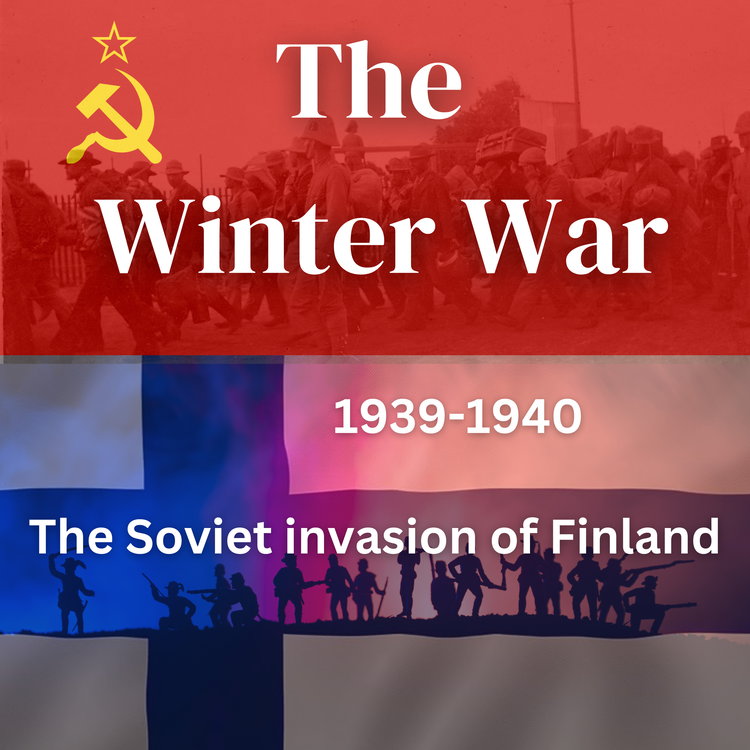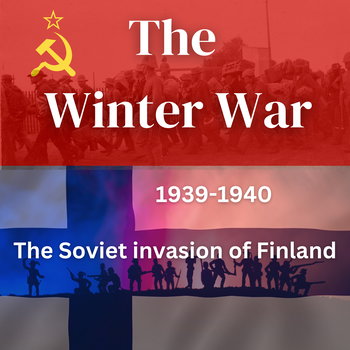
Episode 5 - The Battle for Suomussalmi and Motti Ops develop
Loading player...
Last we heard how the Russian Stavka had taken control of the war directly after a number of mishaps, the Finns had managed to stymie the mighty Red Army which launched its invasion without warning on November 30th.
120 000 Russian soldiers backed up by 1500 artillery pieces, 1400 tanks and about 1000 planes had initially launched part of the invasion along the Karelian Isthmus - this was the Soviet Seventh Army. The Finnish forces facing them were tiny by comparison, almost ten percent of the size, 26 000 infantry, 71 artillery pieces and no tanks.
Helsinki couldn’t call on an air force, they had virtually no planes.
The Russian Seventh Army led by Vladimir Grendahl was tasked with seizing the Karelian isthmus, targeting both the east up against Lake Ladoga and the west, via Viipuri along the Baltic Coast.
As you heard previously, the Eastern sector had been a nightmare, with the Russians held up at Taipale — the Finnish artillery in particular had scored many hits on the Red Army moving across open land, and as they tried to cross the Taipale River.
AFter the setbacks, the Stavka increased the size of the infantry to 250 000, added another 300 artillery pieces and tanks and air support was bolstered.
The Russians shifted their attention on the Isthmus back to the western edge, towards Viipuri. The Finnish Army Second Corps comprised of the 1st, 4th, 5th and 11th Divisions were here, fighting stoically against the invasion, but were short of reinforcements. At Summa, Colonel Selim Isakson’s 5th Division awaited the Russians, to their left was the 1st Division led by Laaitikainen, and on their left, Colonel Koskimies 11th Division.
Orders were sent by Carl Gustaf Mannerheim on 5th December to hold the ground at all costs. The Finnish high command also issued a statement on how to defeat the dreaded Russian tanks.
“… if the enemy tanks at times manage to break through our lines, our troops must hold their ground and calmly destroy the infantry following in the wake of their armour…”
One of the main Soviet objectives was to hit the 12 kilometer area between Summa village and a large lake called Muolaanjarvi. The Russians were going to strike this area repeatedly, and were repeatedly repulsed until the end of December.
But its time to cast our gaze further north, to the Battle for Suomussalmi which was going to become the symbol of Finnish resistance in the coming weeks.
This town of roughly 4000 people lies in the central region of Finland, in the east of what was called the waist of the country, the narrowest part, on the eastern side close to the Russian border.
Suomussalmi was a provincial centre, the town was made up mostly of loggers and hunters although seasonal fishing was also part of its economy. The Russian plan was to take the town, then drive directly west, thus splitting the country in two as they focused on the Baltic harbour town of Oulu.
Suomussalmi region characterised by long twisty lakes that radiate outwards from the road junction.
At 8am on the 30th November the Soviet 163rd Rifle Division led by Brigade Commander Andrew Zelentsov launched an attack the village of Lonkka just over the border. Zelentsov’s strategy was to attempt to take Suomussalmi from two directions - a two pronged attack and at first his forces managed to advance 15 kilometers.
It’s safe the say that the Finns were startled that their enemy had bothered to attack this area at all, even more so that they’d arrived in force. The individual motti's received many names used during the battles - mainly in an attempt at deceiving Soviet intelligence - but in time, they all received an "official" name, usually according to the nearest town or village.
Tactically, it went like this. A combat team was sent to an assembly area just out of reach of the Red Army reconnaissance patrols while Finnish scouts reccied the best concealed routes to the road from these assembly areas.
120 000 Russian soldiers backed up by 1500 artillery pieces, 1400 tanks and about 1000 planes had initially launched part of the invasion along the Karelian Isthmus - this was the Soviet Seventh Army. The Finnish forces facing them were tiny by comparison, almost ten percent of the size, 26 000 infantry, 71 artillery pieces and no tanks.
Helsinki couldn’t call on an air force, they had virtually no planes.
The Russian Seventh Army led by Vladimir Grendahl was tasked with seizing the Karelian isthmus, targeting both the east up against Lake Ladoga and the west, via Viipuri along the Baltic Coast.
As you heard previously, the Eastern sector had been a nightmare, with the Russians held up at Taipale — the Finnish artillery in particular had scored many hits on the Red Army moving across open land, and as they tried to cross the Taipale River.
AFter the setbacks, the Stavka increased the size of the infantry to 250 000, added another 300 artillery pieces and tanks and air support was bolstered.
The Russians shifted their attention on the Isthmus back to the western edge, towards Viipuri. The Finnish Army Second Corps comprised of the 1st, 4th, 5th and 11th Divisions were here, fighting stoically against the invasion, but were short of reinforcements. At Summa, Colonel Selim Isakson’s 5th Division awaited the Russians, to their left was the 1st Division led by Laaitikainen, and on their left, Colonel Koskimies 11th Division.
Orders were sent by Carl Gustaf Mannerheim on 5th December to hold the ground at all costs. The Finnish high command also issued a statement on how to defeat the dreaded Russian tanks.
“… if the enemy tanks at times manage to break through our lines, our troops must hold their ground and calmly destroy the infantry following in the wake of their armour…”
One of the main Soviet objectives was to hit the 12 kilometer area between Summa village and a large lake called Muolaanjarvi. The Russians were going to strike this area repeatedly, and were repeatedly repulsed until the end of December.
But its time to cast our gaze further north, to the Battle for Suomussalmi which was going to become the symbol of Finnish resistance in the coming weeks.
This town of roughly 4000 people lies in the central region of Finland, in the east of what was called the waist of the country, the narrowest part, on the eastern side close to the Russian border.
Suomussalmi was a provincial centre, the town was made up mostly of loggers and hunters although seasonal fishing was also part of its economy. The Russian plan was to take the town, then drive directly west, thus splitting the country in two as they focused on the Baltic harbour town of Oulu.
Suomussalmi region characterised by long twisty lakes that radiate outwards from the road junction.
At 8am on the 30th November the Soviet 163rd Rifle Division led by Brigade Commander Andrew Zelentsov launched an attack the village of Lonkka just over the border. Zelentsov’s strategy was to attempt to take Suomussalmi from two directions - a two pronged attack and at first his forces managed to advance 15 kilometers.
It’s safe the say that the Finns were startled that their enemy had bothered to attack this area at all, even more so that they’d arrived in force. The individual motti's received many names used during the battles - mainly in an attempt at deceiving Soviet intelligence - but in time, they all received an "official" name, usually according to the nearest town or village.
Tactically, it went like this. A combat team was sent to an assembly area just out of reach of the Red Army reconnaissance patrols while Finnish scouts reccied the best concealed routes to the road from these assembly areas.

